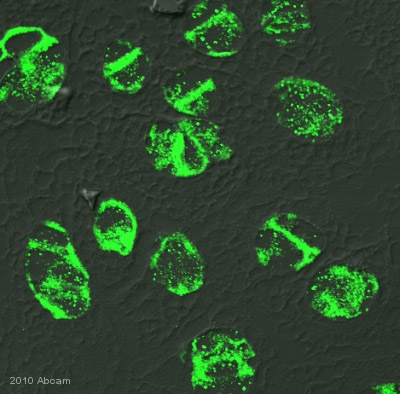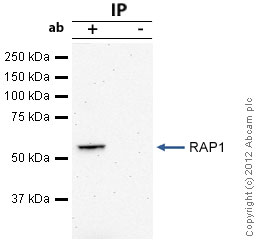
ab14404 staining RAP1 in the 184A1 epithelial cell line from Human mammary glands by ICC/IF (Immunocytochemistry/immunofluorescence). Cells were fixed with methanol/acetone (1:1), permeabilized with 1% Triton X-100 in PBS and blocked with 1% BSA for 10 minutes at 21°C. Samples were incubated with primary antibody (1/50 in PBS + 1% BSA) for 1 hour at 21°C. An undiluted Alexa Fluor®488-conjugated Donkey anti-mouse IgG polyclonal was used as the secondary antibody.See Abreview
![All lanes : Anti-RAP1 antibody [4c8/1] (ab14404) at 5 µg/mlLane 1 : HeLa (Human epithelial carcinoma cell line) Whole Cell Lysate Lane 2 : HEK293 (Human embryonic kidney cell line) Whole Cell Lysate Lane 3 : HepG2 (Human hepatocellular liver carcinoma cell line) Whole Cell Lysate Lane 4 : A431 (Human epithelial carcinoma cell line) Whole Cell Lysate Lysates/proteins at 20 µg per lane.SecondaryGoat polyclonal Secondary Antibody to Mouse IgG - H&L (HRP), pre-adsorbed at 1/5000 dilutiondeveloped using the ECL techniquePerformed under reducing conditions.](http://www.bioprodhub.com/system/product_images/ab_products/2/sub_4/20677_RAP1-Primary-antibodies-ab14404-4.jpg)
All lanes : Anti-RAP1 antibody [4c8/1] (ab14404) at 5 µg/mlLane 1 : HeLa (Human epithelial carcinoma cell line) Whole Cell Lysate Lane 2 : HEK293 (Human embryonic kidney cell line) Whole Cell Lysate Lane 3 : HepG2 (Human hepatocellular liver carcinoma cell line) Whole Cell Lysate Lane 4 : A431 (Human epithelial carcinoma cell line) Whole Cell Lysate Lysates/proteins at 20 µg per lane.SecondaryGoat polyclonal Secondary Antibody to Mouse IgG - H&L (HRP), pre-adsorbed at 1/5000 dilutiondeveloped using the ECL techniquePerformed under reducing conditions.

RAP1 was immunoprecipitated using 0.5mg Hela whole cell extract, 5µg of Mouse monoclonal to RAP1 and 50µl of protein G magnetic beads (+). No antibody was added to the control (-). The antibody was incubated under agitation with Protein G beads for 10min, Hela whole cell extract lysate diluted in RIPA buffer was added to each sample and incubated for a further 10min under agitation.Proteins were eluted by addition of 40µl SDS loading buffer and incubated for 10min at 70oC; 10µl of each sample was separated on a SDS PAGE gel, transferred to a nitrocellulose membrane, blocked with 5% BSA and probed with ab14404.Secondary: Goat polyclonal to mouse IgG light chain specific (HRP) at 1/5000 dilution.Band: 55kDa; RAP1
![Overlay histogram showing HeLa cells stained with ab14404 (red line). The cells were fixed with 80% methanol (5 min) and then permeabilized with 0.1% PBS-Tween for 20 min. The cells were then incubated in 1x PBS / 10% normal goat serum / 0.3M glycine to block non-specific protein-protein interactions followed by the antibody (ab14404, 1µg/1x106 cells) for 30 min at 22ºC. The secondary antibody used was DyLight® 488 goat anti-mouse IgG (H+L) (ab96879) at 1/500 dilution for 30 min at 22ºC. Isotype control antibody (black line) was mouse IgG2b [PLPV219] (ab91366, 2µg/1x106 cells) used under the same conditions. Acquisition of >5,000 events was performed.](http://www.bioprodhub.com/system/product_images/ab_products/2/sub_4/20679_RAP1-Primary-antibodies-ab14404-5.jpg)
Overlay histogram showing HeLa cells stained with ab14404 (red line). The cells were fixed with 80% methanol (5 min) and then permeabilized with 0.1% PBS-Tween for 20 min. The cells were then incubated in 1x PBS / 10% normal goat serum / 0.3M glycine to block non-specific protein-protein interactions followed by the antibody (ab14404, 1µg/1x106 cells) for 30 min at 22ºC. The secondary antibody used was DyLight® 488 goat anti-mouse IgG (H+L) (ab96879) at 1/500 dilution for 30 min at 22ºC. Isotype control antibody (black line) was mouse IgG2b [PLPV219] (ab91366, 2µg/1x106 cells) used under the same conditions. Acquisition of >5,000 events was performed.

![All lanes : Anti-RAP1 antibody [4c8/1] (ab14404) at 5 µg/mlLane 1 : HeLa (Human epithelial carcinoma cell line) Whole Cell Lysate Lane 2 : HEK293 (Human embryonic kidney cell line) Whole Cell Lysate Lane 3 : HepG2 (Human hepatocellular liver carcinoma cell line) Whole Cell Lysate Lane 4 : A431 (Human epithelial carcinoma cell line) Whole Cell Lysate Lysates/proteins at 20 µg per lane.SecondaryGoat polyclonal Secondary Antibody to Mouse IgG - H&L (HRP), pre-adsorbed at 1/5000 dilutiondeveloped using the ECL techniquePerformed under reducing conditions.](http://www.bioprodhub.com/system/product_images/ab_products/2/sub_4/20677_RAP1-Primary-antibodies-ab14404-4.jpg)

![Overlay histogram showing HeLa cells stained with ab14404 (red line). The cells were fixed with 80% methanol (5 min) and then permeabilized with 0.1% PBS-Tween for 20 min. The cells were then incubated in 1x PBS / 10% normal goat serum / 0.3M glycine to block non-specific protein-protein interactions followed by the antibody (ab14404, 1µg/1x106 cells) for 30 min at 22ºC. The secondary antibody used was DyLight® 488 goat anti-mouse IgG (H+L) (ab96879) at 1/500 dilution for 30 min at 22ºC. Isotype control antibody (black line) was mouse IgG2b [PLPV219] (ab91366, 2µg/1x106 cells) used under the same conditions. Acquisition of >5,000 events was performed.](http://www.bioprodhub.com/system/product_images/ab_products/2/sub_4/20679_RAP1-Primary-antibodies-ab14404-5.jpg)